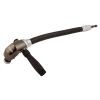Solinst Model 101 Power Winder
Features
- Effortlessly winds longer lengths of tape, cable or tubing on a Solinst reel
- Operates using a standard power drill or driver
- Easy-to-adjust telescoping arms to suit small, medium, and large Solinst reels
- Free ground shipping
- Expedited repair and warranty service
- Lifetime technical support
- More
Overview
The Solinst Model 101 Power Winder is lightweight, easy to attach to the frame of any size Solinst reel-mounted device, and designed to allow ease of use when deploying longer lengths of tape. The convenient Power Winder features adjustable arms and rollers to suit different size reels, as well as other types of Water Level Meters in the market.
Mechanics
A standard drill or driver is used to provide power to the Power Winder, which turns the rollers that are in contact with the reel. The drill can be operated at various speeds, in forward and reverse, to turn the reel and unwind and rewind the tape.
Applications
The Power Winder is ideal for use with Solinst Water Level Measurement Devices, but can also be used with Solinst Tag Lines or pump tubing reels, such as the Model 425 Discrete Interval Samplers. Reels using the Power Winder can be placed on the ground, on a Solinst Field Table, or other flat surface. Small reels can also be secured to a well casing using a tape guide or the optional cinch straps.
In The News
From Paddles to Phytoplankton: Studying Vermont’s Wildest Lakes
For six months of the year, Rachel Cray, a third-year PhD student at the Vermont Limnology Laboratory at the University of Vermont, lives between a microscope and her laptop, running data. For the other six months, she is hiking and canoeing four of Vermont’s lakes, collecting bi-weekly water samples. Cray studies algal phenology across four lakes in Vermont, US, that have low anthropogenic stress—or in other words, are very remote. Funded by the National Science Foundation Career Award to Dr. Mindy Morales, the lakes Cray researches part of the Vermont Sentinel Lakes Program, which studies 13 lakes in the area and, in turn, feeds into the Regional Monitoring Network, which operates in the Northeast and Midwest US.
Read MoreReimagining Water Filtration: How Monitoring and Science Enhance FloWater Filtration Systems
Over 50% of Americans think their tap water is unsafe , according to the Environmental Working Group (EWG). Other recent surveys have found that number to be as high as 70% of persons surveyed. Whether due to increased public awareness of water quality issues or confusion about how municipal water sources are regulated, there is a clear distrust of tap water in the United States. According to industry expert Rich Razgaitis, CEO and co-founder of the water purification company FloWater, this issue creates a damaging cycle. Razgaitis explained that the health and environmental problems associated with contaminated water aren’t the only issues. As people become increasingly aware that some tap water is unsafe, they resort to bottled water.
Read MoreMonitoring New Hampshire’s Aquatic Ecosystems: Continuous Data Collection in the Lamprey River Watershed
New Hampshire’s aquatic ecosystems provide a range of ecosystem services to the state and region. Resources and services like clean water, carbon storage, climate regulation, nutrient regulation, and opportunities for recreation all depend on New Hampshire’s aquatic ecosystems remaining healthy. Jody Potter, an analytical instrumentation scientist at the University of New Hampshire (UNH), is studying these aquatic ecosystems in hopes of developing an improved understanding of ecosystem services and their interactions with climate change, climate variability, and land use changes. [caption id="attachment_39799" align="alignnone" width="940"] Aquatic sensors in the Merrimack River in Bedford, NH, with I-293 in the background.
Read More









